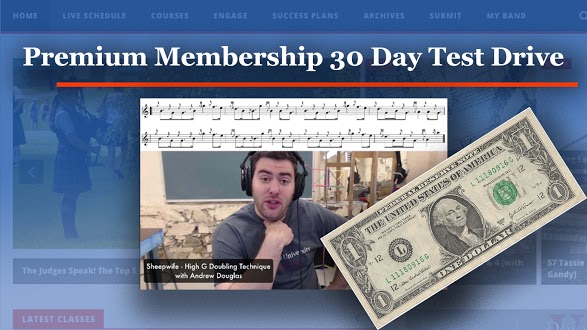Target Practice

Struggling with a section of a tune or a particular note progression? Do you spend a lot of time browsing through exercise books to find the right exercise and it still doesn’t help? How do you break down and target an issue in a way that is fun and effective?
Carl uses arpeggios to demonstrate how to create our own exercises to target and practice those trouble areas in our music and fingerwork.
Click here now to listen to this as a podcast. Find the Piper’s Dojo Audio Experience podcast on Apple iTunes, SoundCloud, Spotify, Google Podcasts -- or wherever you listen to your podcasts.Listen to This As a Podcast
Video Transcription:
So here's what we're getting at today. We're going to be looking at developing your own exercises to target things that you need to fix. Hopefully, you guys can see here I have started a little exercise for us today, and something I wanted to look at was, well arpeggios. If we're looking at arpeggios, what's one of the main trouble we have with our arpeggios? Well, one of the main issues, if it's not timing, it's going to be crossing noises. Oh, you guys are getting good at this, getting very good at this. Yeah, crossing noises. That's the main risk with arpeggios. We have two types of crossing noises, of course. We have the lift drop and the rolling. You'll see that depending on which arpeggio we play, some are a little bit more common than others. Things with Fs or high Gs have the tendency to have more rolling crossing noises than a lift drop. But in any case, we have to be on the lookout for both types of crossing noises anytime we find an arpeggio.
Remember, arpeggios are one of the basic building blocks of music. That, along with scale runs, these are the two things that we use in conjunction to make a tune, so make sure you're on the lookout for these. It's a good way on which we can sort of sort out the music and figure out how best to play it, sort of predict what errors are possible and what errors I should be looking out for. That's one of the things that helps me and other teachers really listen in for the right thing at the right time, because we know sort of what to expect in what places and the common mistakes, and so we're on double lookout for those sorts of things. Identifying that it's an arpeggio, for example, in a little section, you should think as you did there, crossing noises. Okay, let me double check that I'm not playing any crossing noises.
But, let's say you're having some trouble here with some crossing noises in a tune, and let's say that's in an example of an arpeggio. How about an A major arpeggio? What's a good way here to create an exercise? Any ideas? I mean, we're going to do it here together, but what are some of the things that I should think about when making an exercise? No, I mean in general, because what I have on screen so far is not an A major arpeggio, but you can maybe infer some things from the first two bars. Include spots that give you the most trouble, breaking them down into the components, that's a great idea. Use notes from trouble phrases. Yeah, exactly. A major. Yes.
Dave, an arpeggio is simply a chord that's split apart. A chord being several notes played at the same time, and we can give those names based on the key or chord that they are. So like an A major chord would be A, C, and E. In this case, an A major arpeggio splits those notes apart, A, C, and E, so that would be an A major. Yes. C#. You're correct. I'm a bad bagpiper and I don't differentiate the fact that our C is a C#, but that is true. It's A, C#, E. It's an A major arpeggio. I like those so far. Those are good suggestions. Recreate little bits but, and I think it was Beth that said this, break it down into the components. I think that's a very key thing.
I don't have a great example of this, but if you have a ... Let's do it this way. If you have an A, C, E, in which case this note here, this is going to be a cut note, and this will make a dotted note. So if this, for example, is the troublesome bit, we can also break it up a little differently. Let's put another C after this, because that'll make it difficult. A short E, right? A cut E, an ASAP E in between two Cs, that sounds like a great place to make a big old fat crossing noise. Here we are with a good example of something that you might lift from a tune that's rather difficult. We get a challenging bit here.
We can also recreate this a little bit slower, and I'm just sort of making this up as I go. I'm not too concerned with a melody, because this is going to sound melodic no matter what because we're playing our arpeggios. That's kind of the really cool part of arpeggios. You can put pretty much anything if you stay in the same arpeggio, one after the other, and it's going to sound somewhat melodic, so I'm not too worried about this in an exercise. It's really a good thing. The more awkward it is sometimes, sometimes, the better an exercise it is. Good. So let's group those together, or beam them together. Now, we have a full bar in 4/4. I've decided to write this in 4/4 because why not? It could be in 2/4, but that doesn't really matter. Or if you're working in compound time, obviously you can copy that.
But we can also take, let's use our example as beat two of this bar is being a little bit difficult. You can take that apart like this. We can see now, we've taken out, in a way, that dot cut, but we're playing the same notes right after that so that we have time to focus on that specific note change. In 4/4, that would be one beat per note. We get plenty of time, especially if we're going to do this in double time. Are we done? Can we use this exercise already? I'm talking most about bars three and four. Are we ready to play this? Yeah.
John says, I'd add gracenotes. You sort of have too, in a way, and you definitely should, even if you don't have to. What gracenotes am I going to start with? What are the most important gracenotes and where should I put them? Vic says, Gs, on the beat. Yes, exactly. That's the million dollar answer. G gracenotes on the beat. Generally speaking, that's a great idea. Putting a G gracenote here would be kind of awkward, especially on a cut note. It's going to sound weird, and it's going to be extremely difficult to play. G gracenotes also help us articulate things, so I might be inclined, especially if I know I'm having trouble with something, to put a gracenote here. On the other hand, I might leave it out, to make sure that there's not also a synchronization error, or maybe you want to do the the opposite, right? Change your exercises as much as you like.
All right, so I've put in most of the G gracenotes I want. Is there anything else I'm missing here between the Cs? Yeah, right. I wrote this rhythmically, that there's two Cs and so I need a way of separating them. Exactly. You guys got it. So I could put another G gracenote. I could put a D gracenote. I could put a strike. Doesn't really matter, it depends on what you want to practice on, what kind of things you'd like to practice. I would sort of prefer a strike. It keeps also in line with what we're practicing here, which is crossing noises, and a C to C strike has the possibility of a rolling crossing noise in it. That's a good way to put that in there. And you've noticed maybe before that I've put a strike in already on F, so it sort of keeps in with what I'm doing.
But the rule here is that there's no real rules, other than G gracenotes should go on the beat, generally. Stick in an arpeggio for this sort of exercise, but make your own exercises however you like them. It's good to vary note length, rhythm, you'll see almost all of this is even, we can change that if we want, but let's leave it even for a moment. To recap, a great way to set up your own exercises is using a sheet of paper or a program like this, whatever works, and pull out a little section of something that's bothering you, repeat it, change it around, but try to stick in the same arpeggios, in the same key, if you will.
Enjoying this content and want to try Dojo U? Try our Premium Membership for a full month for just one dollar by clicking here now!Try a Dojo U Premium Membership for $1






Responses